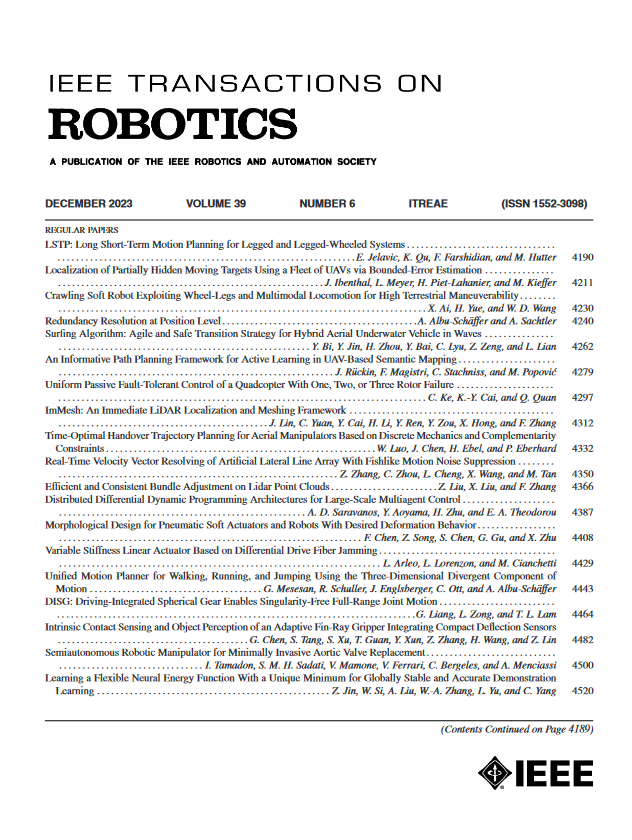Modeling, Embedded Control, and Design of Soft Robots Using a Learned Condensed FEM Model
IF 9.4
1区 计算机科学
Q1 ROBOTICS
引用次数: 0
Abstract
The finite element method (FEM) is a powerful modeling tool for predicting soft robots' behavior, but its computation time can limit practical applications. In this article, a learning-based approach based on condensation of the FEM model is detailed. The proposed method handles several kinds of actuators and contacts with the environment. We demonstrate that this compact model can be learned as a unified model across several designs and remains very efficient in terms of modeling since we can deduce the direct and inverse kinematics of the robot. Building upon the intuition introduced in (Ménager et al., 2023), the learned model is presented as a general framework for modeling, controlling, and designing soft manipulators. First, the method's adaptability and versatility are illustrated through optimization-based control problems involving positioning and manipulation tasks with mechanical contact-based coupling. Second, the low-memory consumption and the high prediction speed of the learned condensed model are leveraged for real-time embedding control without relying on costly online FEM simulation. Finally, the ability of the learned condensed FEM model to capture soft robot design variations and its differentiability are leveraged in calibration and design optimization applications.基于压缩有限元模型的软体机器人建模、嵌入式控制与设计
有限元法是预测软体机器人行为的一种强大的建模工具,但其计算时间限制了实际应用。本文详细介绍了一种基于学习的有限元模型压缩方法。该方法处理了多种类型的执行器以及与环境的接触。我们证明了这个紧凑的模型可以作为一个统一的模型在多个设计中学习,并且在建模方面仍然非常有效,因为我们可以推断机器人的正运动学和逆运动学。基于(msamnager et al., 2023)中介绍的直觉,学习到的模型作为建模、控制和设计软操纵器的一般框架提出。首先,通过涉及基于机械接触耦合的定位和操作任务的基于优化的控制问题来说明该方法的适应性和通用性。其次,利用学习到的压缩模型的低内存消耗和高预测速度进行实时嵌入控制,而不依赖于昂贵的在线FEM仿真。最后,将学习到的压缩有限元模型捕获软机器人设计变化及其可微性的能力用于校准和设计优化应用。
本文章由计算机程序翻译,如有差异,请以英文原文为准。
求助全文
约1分钟内获得全文
求助全文
来源期刊

IEEE Transactions on Robotics
工程技术-机器人学
CiteScore
14.90
自引率
5.10%
发文量
259
审稿时长
6.0 months
期刊介绍:
The IEEE Transactions on Robotics (T-RO) is dedicated to publishing fundamental papers covering all facets of robotics, drawing on interdisciplinary approaches from computer science, control systems, electrical engineering, mathematics, mechanical engineering, and beyond. From industrial applications to service and personal assistants, surgical operations to space, underwater, and remote exploration, robots and intelligent machines play pivotal roles across various domains, including entertainment, safety, search and rescue, military applications, agriculture, and intelligent vehicles.
Special emphasis is placed on intelligent machines and systems designed for unstructured environments, where a significant portion of the environment remains unknown and beyond direct sensing or control.
 求助内容:
求助内容: 应助结果提醒方式:
应助结果提醒方式:


